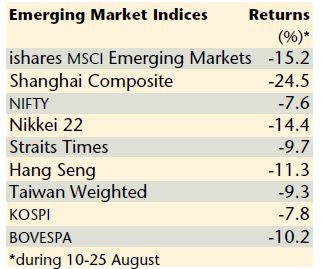
India could attract more foreign investments due to the uncertainty in China
China’s move to devalue the yuan by 2 percent to support its export-driven economy has stoked concern amongst investors on the state of its economy. Since this announcement, yuan has fallen in excess of 3.2 per cent. Investors fear this could be the beginning of a long-term depreciating trend, which could create a spiral effect in other emerging market (EM) currencies. The Chinese slowdown is likely to have repercussions across the globe, resulting in exodus of funds from a riskier asset class to a safer asset class. Chinese economy is slowing down. The China’s Manufacturing PMI came in at 47.1 in August, contracting at the fastest pace in more than six years.
Stock markets across the globe have corrected sharply. Commodity prices are on a downward spiral. Crude oil has fallen to a six-and-a-half year low. Currencies across the EMs are weakening due to ongoing risk-off trades happening globally. The fall is more dramatic for emerging economies dependent on commodities.
Since the end of 2014, China has been loosening its monetary policy to revive its slowing economy. But the liquidity generated through loosening has made way into Chinese stocks instead of going into real economy, creating bubbles in the Chinese stock markets. Shanghai Composite index had gained 108% between 1st Nov 2014 and 15th Jun 2015 despite slowing economy. Regulators had to take urgent steps to restrict inflow of hot money into its stock markets.
Investors fear Chinese slowdown could be more severe than what is reflected from the government data. Chinese markets have fallen 43 per cent between 12 June and 25 August and by over 24 per cent since China devalued its currency on 10th August. Even after this correction, the Shenzen Composite Index is still quoting at a P/E of over 40 times (see table).
The exodus of foreign investors from Chinese markets is an opportunity for India to attract foreign investments. The Indian economy is on the mend and the government is determined to resolve structural issues. Earnings of companies are likely to pick up going forward. The fall in global commodities has improved India’s fiscal position and has lowered inflation. This has helped companies improve gross margins as is reflected in the June 2015 quarter results. Fundamentals of India are much stronger than most EM peers.
China is undergoing a difficult transition phase with a slowing economy and high fiscal deficit. Strong multi-decadal growth funded through excessive bank credit has created bubbles in various asset classes. China lags far behind India in the robustness of its banking sector. China’s domestic credit to private sector stood at 141 per cent of GDP, as against 51 per cent in India in 2014. As China slows down, there is a risk of rising NPAs, which will put pressure on the already fragile banking sector. This could have systemic repercussions on their economy. India’s banking system is extremely robust under RBIs vigil.
As the economy slows, foreign companies with a presence in China are looking for alternative investment avenues as a part of their de-risking strategy. This will attract more FDI to India. The government of India is actively working to improve the investment climate in the country. India, which ranks 142nd out of 189 countries on the Ease of doing business scale, now aims to be among the top 30 on this list.
DIPP has released a framework to assess and rank states in terms of ease of doing business to encourage competition among states. The Government wants to improve transparency by promoting digitalization and cut red-tapism. For instance, MSME has recently replaced a 20-page long registration form with just one-page Udyog Aadhar form.
The Government is closely monitoring ongoing turbulence in the global markets. Over past eighteen months RBI has accumulated huge Forex reserves to face any eventualities arising from global factors. India’s Forex reserves as of 14th Aug stood at $354 billion as compared to $292 billion in Jan 2014. RBI is ready to intervene in the Forex markets to curb volatility. USD/INR closed at two-year low of 66.28 after hitting an intraday low of 67.06 on 25th August 2015.
Indian markets have fared much better than other EMs in the recent correction. The rupee has remained fairly resilient and has been one of the best performing currencies among EMs over last one year. Looking at India’s fundamentals, once the clouds of global uncertainty disperse, India will rebound from the steep correction and come out stronger. China’s pain could turn out to be India’s gain.
This article was originally published in Business India Magazine.
Write to us at news@valuelineadvisors.com
Disclaimer: The views expressed in this article are personal and the author is not responsible in any manner for the use which might be made of the above information. None of the contents make any recommendation to buy, sell or hold any security and should not be construed as offering investment advice.
